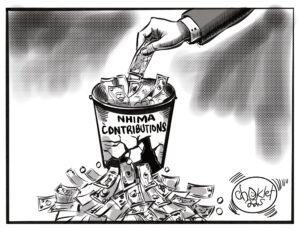On the 21st September of 2018, News Diggers published my article titled, “Is Zambia ready for the Saudi Arabian goat and sheep export market?” The article is available here.
In that article, I made a recommendation, that the government must start by commercialising the currently informal small ruminants (goats and sheep) value chain through a cooperative market model which will be run by farmers, with the government only playing the value chain governance and technical guidance role.
In this week’s article, I am explaining why formalising the small ruminants value chain will have a significant impact on rural livelihoods in Zambia. I will start by briefly describing: what is meant by commercialising the value chain; what a value chain is; the agriculture sector in Zambia; the current statistics on numbers of households keeping livestock and their distribution; number, type and distribution of livestock reared based on the Central Statistical Office 2017 preliminary livestock and aquaculture census results. I will not discuss the accuracy of these census results because this is a story for another day. However, I need to make a note that statistics are vital. Wrong statistics can derail or give wrong figures for planning and accordingly wrong projections. Thus the data generated by those mandated to provide accurate statistics should strive at all costs to produce close to correct figures as what obtains on the ground.
What is commercialisation of the small ruminant value chain?
In this context, commercialisation of the small ruminant value chain means developing a well-organised system with capital resources, infrastructure, institutions, legal frameworks and markets (Roets and Kirsten, 2005). The existing international, regional and local niche markets that remain to be exploited, coupled with shifts in global consumer preferences and demand have opened up the possibility of commercialising the small ruminant value chain.
What is a value chain?
A value chain consists of “the full range of activities which are required to bring a product or service from conception, through the different phases of production, delivery to final consumers, and final disposal after use”(Kaplinsky and Morris, 2001). At one end of the agricultural value chain are the producers – the farmers who grow crops and raise animals. At the other end are the consumers who eat, drink, wear and use the final products. In the middle are many thousands of men and women, and small and large businesses. Each person and each business performs one small step in the chain, and each adds value along the way by growing, buying, selling, processing, transporting, storing, checking, packaging, and disposing. All these activities and processes add to the value chain. The agriculture value chain is one of the most important and significant in terms of sheer volumes traded and magnitude yet it is still one of the most neglected.
Agriculture Sector in Zambia
Zambia covers 75 million hectares (752,000 km2), out of which 58% (42 million hectares) is classified as medium to high potential for agriculture production (ESLIP, 2016). The Zambian agriculture sector is mainly comprised of crop, livestock and fish production. Three broad categories of farmers exist in Zambia: small-scale (these are mostly under the traditional sector), medium (emergent farmers), and large-scale (World Bank, 2011). Small-scale farmers are generally subsistence producers of staple foods with an occasional marketable surplus and consist the greater majority of farmers for both crop and livestock production. Most of the farmers practice a mixed crop-livestock farming system, which is only integrated to a lesser extent. National emphasis has been on crop production mainly maize given that it is a staple food. However, crop production is seasonal and rain-fed due to inadequate irrigation technologies. On the other hand, livestock production is practised throughout the year and takes the first option of liquidity when there is a financial need in a household. The government is emphasising on the need for diversification to other crops besides maize, and other livestock besides cattle, even though this has been on paper and not actualised.
Number and distribution of households raising different types of livestock in Zambia
Table 1 shows that goat keeping households are more widely distributed in all provinces compared to cattle keeping households, which are mostly concentrated in four (4) provinces, namely Eastern, Central, Western and Southern (CSO 2017). This means that strategically formalising the goat value chain will lead to a broader or evenly distributed wealth in all the provinces, which will eventually have more impact on the socioeconomic determinants linked to the development of this country.
Number, type and distribution of livestock in Zambia
Figure 1 shows that cattle and goats are the mostly reared type of livestock. Again, cattle distribution is more biased to Southern, Eastern, Central and Western provinces, due to among other factors, lifestyle as well as a cultural heritage, and the presence of the Kafue and Zambezi floodplains, which provide a good environment for agro-pastoralism. Much as 35% of goats and sheep are concentrated in the Southern province, the numbers are more widely or evenly distributed among all provinces in Zambia. This again provides leverage for pro-poor socioeconomic development through commercialisation of goat and sheep value chain.

What do we learn from these statistics?
When we talk about agriculture in Zambia, what comes to our mind is crops and how Farmer Input Support Program (FISP) and Food Reserve Agency (FRA) take more than 70% of our budgetary allocation to agriculture. Similarly, when we talk about livestock in Zambia, what comes to our mind is cattle. In the livestock subsector, our budget has always been skewed towards the control of cattle Diseases of National Economic Importance such as Contagious Bovine Pleuropneumonia (CBPP) and Foot and Mouth Disease (FMD). What has been the impact of our current way of doing things? Are our so-called pro-poor interventions yielding great results, which are widely distributed? Are we paying lip service to the development of the export-led livestock sector? Where do we put small ruminants? Do we understand the potential of commercialising the small ruminants value chain? Fortunately, the 2019 budget seems to answer some of these questions through the allocation of K483.2 million towards climate resilient livestock management and small ruminant value chain support project. Though not much, this is a step in the right direction. The big question is, what strategies have been put in place to actualise the small ruminant value chain support through the 2019 budgetary allocation? I will leave this question for the relevant ministries to reflect upon, as they will be spending the K483.2 million allocated towards climate resilient livestock management and small ruminant value chain support project. I will provide some options in the next article.
From these statistics, we learn that the numbers of households keeping small ruminants are more or less evenly and widely distributed across all the provinces, and so is the number of goats and sheep. Some of the reasons behind this observed countrywide distribution of goats and sheep are:
1. Small ruminants require less capital and cash to buy and maintain;
2. They are more convenient for distress sales while the death of a single animal is less damaging compared to cattle;
3. They grow and breed faster and can often thrive on harsher terrain;
4. Having made an initial investment in small ruminants, it may be possible to expand and having accumulated a large enough flock, to switch to cattle.
Therefore, poor farmers are more likely to own poultry, sheep and goats rather than large stock. This means that investing in commercialising the small ruminant value chain will have significant benefits, among them:
1. Broad involvement of households in poverty alleviation through small ruminant production, marketing and consumption. A goat is an attractive livestock for poverty reduction.
2. Broad involvement of households in contributing to national food and nutritional security. Zambia has more than 40% of undernourished children (UNICEF 2017). This calls for broad participation of remedying the problem of undernourishment. Therefore, commercialising small ruminant value chain is a potential remedy for malnutrition;
3. Wide distribution in the creation of direct and indirect jobs along the entire small ruminant value chain;
4. A broad allocation of national resources through small ruminant production, marketing and consumption;
5. Broad participation of households in the diversification agenda from copper to of agriculture led export economy;
6. Gender and social inclusiveness in national economic activities. In most cultures in Zambia, men own cattle and only a male child inherit when the male household head passes on (Randolph et al, 2007). However, women mostly own small livestock such as goats and chickens. Commercialising the small ruminant value chain has a potential of involving more women and other marginalised communities in livestock production. A joint involvement of male and female in goat rearing regardless of social strata is a catalyst for national socioeconomic development.
Looking at the highlighted benefit, it cannot be overemphasised that commercialisation of the small ruminant value chain will have a significant and broad socioeconomic impact on rural livelihoods in Zambia. This however, does not suggest ignoring investment into the cattle production. Let us end with the following questions: Who should commercialise the small ruminant value chain in Zambia, and how can this be done? How can we stimulate demand on the consumption side? I will answer these questions in the next article.
Chisoni Mumba (PhD) is a Lecturer of Animal Health Economics at the University of Zambia, School of Veterinary Medicine.
Email: [email protected] , Mobile: +260977717258

























One Response
Great article with great insight Dr Chisoni Mumba